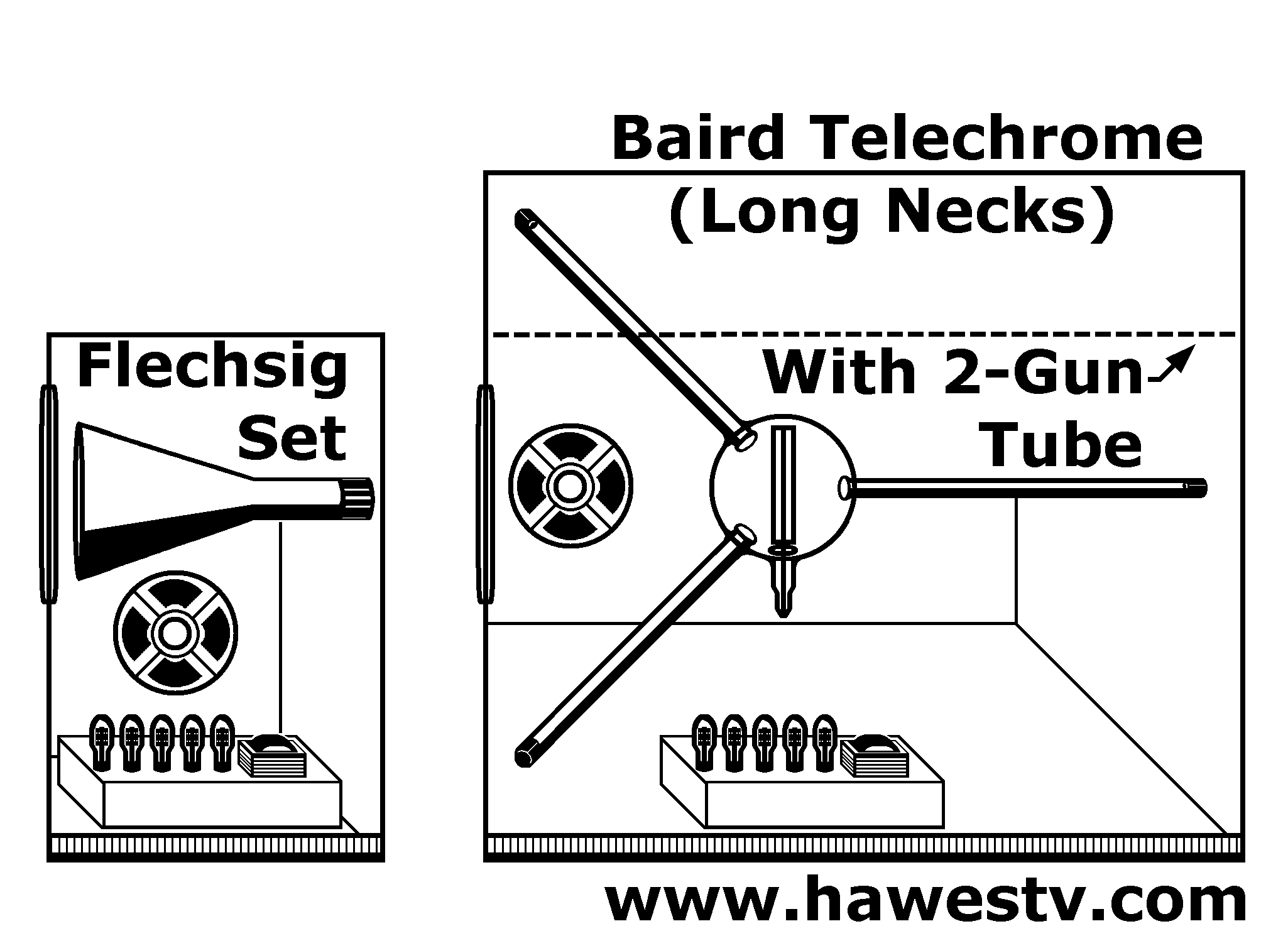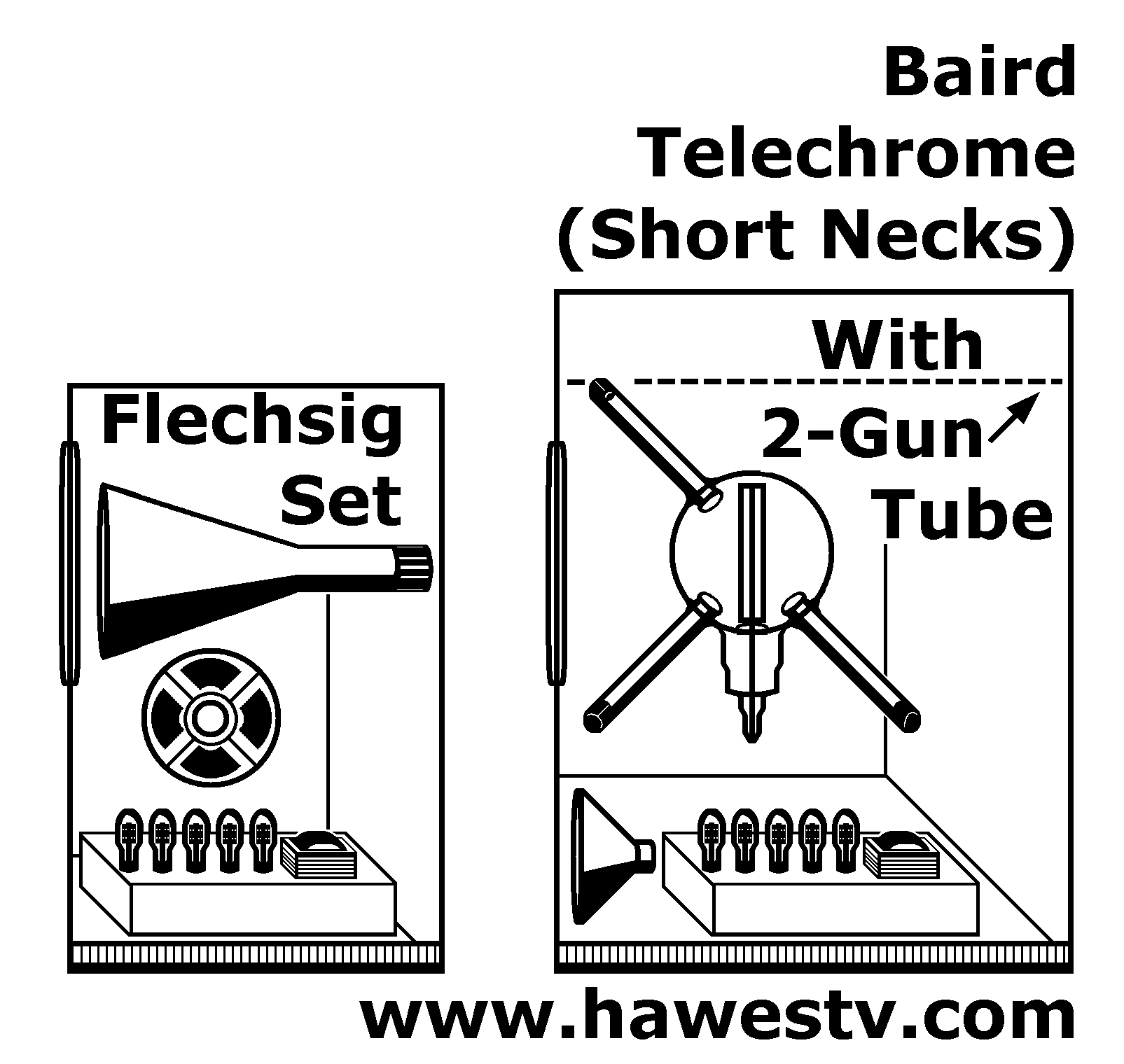|
♦ NOTICE: LATEST REVISION. Make sure that you view the latest revision of this page. On a PC keyboard, simultaneously press <CTRL> and the <R> key. (We also recommend clearing your temporary Internet files. Doing that will assure that you'll see the latest graphics.) |
|
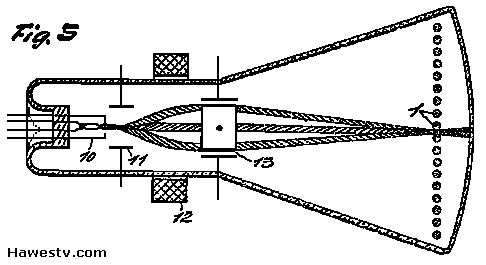
|
|
Flechsig Tube, 1938: Conceptual diagram, Fig. 5 from patent (4., 5., 6. )
|
Winning FeaturesThings to Come. In 1938, Flechsig's tube was the shape of things to come. On the other hand, Baird's Telechrome lacked key features that made Flechsig's tube essential...
Due to Flechsig's advanced design, a color TV could be fairly compact. One can see this clearly from Flechsig's patent drawings. In the 1950s, Rauland Corporation considered manufacturing Flechsig's tube, instead of licensing RCA's patent. (11.) In contrast, neither Rauland nor any other company would produce Baird's Telechrome patent. (That includes John Logie Baird Ltd.) (12.) According to one account, Rauland explicitly rejected the Telechrome in 1944. The reason for rejection was this: The picture was deep inside the tube, rather than on the screen face. (13.) First Shadow MaskGrille or plate. Although Flechsig's shadow mask was primitive, it was probably the first one in the world. (14.) The shadow mask was a grille or perforated plate that distributed colors on the screen. Richard Webb was a pioneering engineer who designed color television equipment for RCA. Webb spoke reverently of the shadow mask color kinescope (CRT). He called it “the single most important development in color TV history.” (15, 16.) How did the shadow mask work?Here are the basics: A color CRT had three electron beams: One for red video, one for green, and one for blue. (The color wasn't in the beams, though. Instead, the color was in the phosphors.) Simultaneously, the three beams shot down the tube neck. In multi-gun picture tubes, electron beams struck the shadow mask, just behind the screen. The shadow mask served as a distributor: Only the correct beam could penetrate the mask and light up its target phosphor. The color phosphors were dots or stripes on the inside of the screen. At any one instant, three beams were active. Simultaneously, each one hit its own phosphor. Each three neighboring, illuminated locations on the CRT face made up one pixel. ( 17.) Varying the intensity (“saturation”) of each location allowed the screen to mix millions of compound colors. (Assuming 256 colors per gun, 2563= 16.7 million colors.) Deflection circuits swept the beams across the screen from side to side and top to bottom. (18.) Flechsig's shadow mask (19.) had a mesh of vertical wires. (See Point 1 on the patent drawing.) This screen design was similar to the one that Lawrence (Chromatic Labs) adopted a few years later. (20., 21.) RCA engineers independently developed their own shadow mask. (22.) Surprise. Hearing of Flechsig's previous work surprised RCA engineers. (23.) Despite its similar function, the RCA shadow mask was distinctly different from Flechsig's. RCA's mask had an etched plate with holes in delta formation. Each delta allowed a triad of red, green and blue beams to pass through to the screen. (24.) Engineer Al Schroeder conceived this type shadow mask for RCA. He received U.S. patent 2,595,548 for his design.(25.) Slotted mask. Later versions of the RCA shadow mask used a slotted mask. This new mask allowed for brighter pictures and easier convergence adjustments. (26.) The illustration below contrasts the two RCA color tube designs vs. the Sony Trinitron design. (Adaptation from Liff 27.) 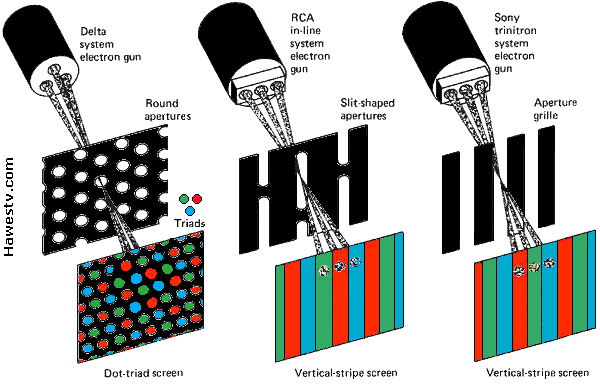
Masks, 3 Types |
Schroeder vs. Flechsig vs. LawrenceAl Schroeder's mask design for RCA turned out to be the right way to go. There was far less leakage between screen colors than with Flechsig's tube. Yet meanwhile, Ernest Lawrence persisted with the wire mesh. (28.) Tenacious problems plagued Dr. Lawrence's Chromatron tube...
Paramount and then Sony took on Chromatron's problems. But neither company could overcome these problems. Yet Lawrence's famous tube, though never practical, inspired the excellence of the Sony Trinitron. (29.) Shadow Mask Tubes vs. TelechromeFar behind. In terms of practicality and performance, the Telechrome was far behind the Flechsig tube or the Chromatron. The Telechrome in Baird's 1944 publicity stunt had only two guns, and two one-color screens. But inside the tube envelope, there was no shadow mask. Instead, the awkward contraption had three necks on three angles to the internal screens. (30.) Telechrome's two guns allowed only two on-screen colors, for a very narrow color gamut. (Assuming 256 colors per gun, 256^2 = 65,536 colors. Yet with three onscreen colors, a tube could reproduce 256^3 = 16.7 million colors!) The Telechrome could produce realistic facial tones. But the picture lacked true green or blue rendition. Neither green grass nor sky blue was possible. (Both of these colors would reproduce as muddy shades of cyan. (31.) Without any of Flechsig's key features, Telechrome's doom was to be the last of its type. Telechrome's design was hopelessly unwieldy. The picture was in the center, rather than on the end of the tube. For that reason, the viewer would have had to peer deep into the TV set. Baird's patent also detailed a three-color version of the Telechrome tube. Adding a gun made the tube even more massive and ungainly. Press reports described the three-color tube as something Baird had given up, which isn't surprising. (32.) Due to the multiple necks, even the two-color set's cabinet would have to be huge. This behemoth would about equal the size of a commercial clothes dryer. |
Telechrome Tube DimensionsHere are some estimated specifications (33.) for the cumbersome Telechrome (the two-color version that Baird displayed in press photos)... |
| Screen dia. | Tube height (incl. support neck) | Gun neck, length | Distance, gun neck to gun neck |
| 10" | 26.1" | 13.8" | 23.6" |
| Support neck, length | Support neck, dia. | Gun neck, dia. | Bulb width |
| 7.2" | 9" | 1.8" | 14.5" |
| Note: Baird used this tube in press conferences. It might have been a non-working mock-up. The electron gun necks are one-third as long as those of the Telechrome on exhibit. (Tube location: National Science & Media Museum, Bradford, England.) (34.) | |||
More Telechrome DrawbacksFlies in the ointment. Telechrome had other problems. Below are just a few. Flechsig's invention bypassed all but one of these Telechrome faults... |
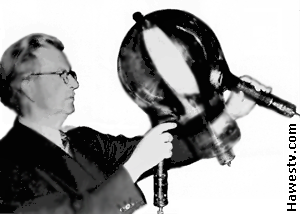
Baird (above), holding 2-gun, 2-color Telechrome tube. This is short-neck version. Glass envelope is from Hackbridge Hewittic rectifier. Telechrome tube could be non-working prop. (No way to know. Bradford museum only has long-neck version, with smaller globe.) (35.) |
|

Two-gun Telechrome tube: Long-neck model. Photo from National Science and Media Museum in Bradford, UK. Author retouched picture to remove background and color cast. (Neck length difference between this tube and tube in above Baird picture is indisputable. In both cases, compare neck length to bulb width.) (37.)
|
|
|
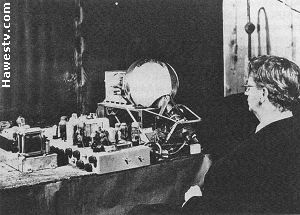
Optical Problems: Notice reflections off tube at 4 o'clock and 10 o'clock. Because tube was clear, external light could project into tube and interfere with image. Notice that target (image area) of tube appears to be curved. Actually, target was flat. Curved surface of tube tended to cause images to bow outward. (Baird with Telechrome, 1944. Photo from Burns.) (43.) 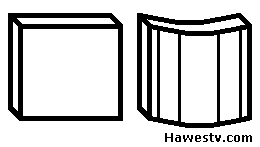
|
Alleged Impact of Flechsig on BairdBaird abandoned Telechrome and switched to line-sequential color in 1942. (53.) One account suggests that in 1943, even Baird considered switching to a shadow mask. (54.) Perhaps Baird had read about Flechsig's work. Alleged Impact of Baird on FlechsigIf envy were invention... One writer imagined that Baird might be responsible for the Flechsig tube. (55.) This notion was a retroactive attempt to expand Baird's portfolio at the expense of Flechsig. The story arose because Baird was one of the founders of Fernseh. (56., 57.) Werner Flechsig was an employee of this German company. (58.) However, the Nazis nationalized Fernseh AG in 1933. That year, Major Church negotiated an arrangement between Baird Television and the German government. Baird Television received a cash settlement. The Bairds never returned to Germany. (59.) After the Bairds' departure, five years elapsed before Flechsig patented his shadow-mask tube. |
|
Another allegation from the Baird occult (60.) posits that Telechrome encouraged the industry to experiment with multiple guns. In a history that defers to Baird, maybe this sentiment is understandable. Yet it's false. The drawing (right) comes from Flechsig's color tube patent. This drawing clearly shows three electron guns, years before Telechrome. (61.) Conclusion: Perhaps Flechsig encouraged Baird to experiment with multiple guns. Baird didn't invent multi-cathode (or multi-neck) tubes, either. For instance, Vladimir Zworykin's first cathode-ray tube (1924 to 1925) had multiple necks. (62.) |
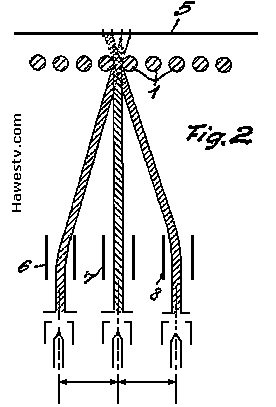
Flechsig tube had 3 guns. |
The Value of TelechromeDespite Nazi bombs that rendered his Sydenham home uninhabitable, Baird doggedly pursued his research. (63.) At last, he produced Telechrome. But why would Baird design an impractical color television tube? According to his wife Margaret, Baird was an avowed socialist (64.): All the justification he’d need for his disinterest in marketability. (65.) Besides, the show was the thing. Baird realized that Telechrome's elephantine proportions might actually impress reporters. Affirmation. About the time of his 1944 Telechrome demonstration (66.), Baird’s health began to decline. (67., 68., 69., 70.) Baird must have yearned for affirmation that his life was worthwhile. Plus, despite his socialism, Baird was burnishing his brand. He wanted a place for Baird television after the war. (71., 72., 73.) In fact, in 1945, Baird and his associates did start a new venture, producing black-and-white console TVs. (74.) Telechrome, although it had no commercial value, had proved a public relations triumph.Not history. Yet public relations aren't history. In the face of naive accounts elsewhere, Telechrome wasn’t the basis of later color CRTs. It couldn’t have been, because it lacked fundamental parts and ignored usability. Nor was Telechrome original, considering its beginning as two monochrome tubes. (75.) (Those with experience in the art could have conceived of Telechrome without inventing new technology.) And Telechrome wasn’t the first color picture tube, unless one ignores prior art. Flechsig's LegacyShadow mask. Flechsig's remarkable tube predicted key innovations that eventually made color TV practical. The most important of these innovations was Flechsig's shadow mask. (76., 77.) Flechsig's tube had it. Baird's Telechrome didn't. Color television manufacturers developed and used a mask of this type for decades, until the CRT became obsolete. Only a world war could upstage and politicize Flechsig's splendid contributions to worldwide communications. Summary: Five more reasons why Flechsig's tube was superior to Telechrome…
Flechsig prototype. A prototype TV with Flechsig's visionary color tube appeared at the 1939 Berlin Radio Show. (Official name: Internationale Funkausstellung Berlin.) (78.) Flechsig's tube debuted years before Baird demonstrated his makeshift Telechrome tube in a Sydenham publicity stunt. (79.) Even as Baird's Telechrome debuted, it instantly became obsolete. Flechsig's shadow mask, and several of his other ideas had already transcended Baird's work. These ideas brought us impeccable, spectacular, and dependable color television for the next 70 years. |
Visit these related pages... |
|||||
|
|
|
||||
References1. Werner Flechsig, “Kathodenstrahlröhre zur Erzeugung mehrfarbiger Bilder auf einem Leuchtschirm” (“Cathode ray tube for the production of multi-colored images on a fluorescent screen”). German Reich patent 736,575 filed July 12, 1938 and issued May 13, 1943. 5. •Re: Shadow-mask tube drawing from Flechsig patent. 2. Ray Herbert, Seeing by Wireless: The Story of Baird Television (Sanderson, Surrey, England: Herbert, 1996), 26. •Re: Claim that Baird invented first color CRT. 3. Douglas Brown, The Three Dimensions of John Logie Baird (Bedford, UK: Radio Society of Great Britain, 2012), 100. •Re: Claim that Baird invented first color CRT. 4. Flechsig, “Cathode ray tube,” Shadow-mask tube drawing, Figure 5 from CRT patent 736,575. •Re: Definitions of callouts on patent drawing, “Figure 5”. 5. Albert Abramson, The History of Television, 1880 to 1941 (Jefferson, NC: McFarland, 1987), 246, 247 and 320, note 69. Abramson's footnote 69 refers to Flechsig's 1938 German color TV tube patent, number 736,575. Issued May 13, 1943. (Also see French patent #866,065. •Re: Flechsig shadow mask tube invention. 6. Albert Abramson, The History of Television, 1942 to 2000 (Jefferson, NC: McFarland, 2003), 41. •Re: Flechsig patent drawings. 7. Harold B. Law, “The Shadow Mask Color Picture Tube: How it Began: An Eyewitness Account of its Early History,” SMPTE Journal 86, no. 4 (April 1977): 220-221. •Re: Shadow mask history from the RCA perspective. Includes essential material on parallel research by Flechsig. Summarizes value of Flechsig's tube. Also notes Flechsig's patented method of depositing color screen. (Entire article: 214-221) 8. Ibid.: 220. •Re: Shadow mask. Compares similar color CRTs and shadow masks by A.C. Shroeder at RCA and Werner Flechsig in Germany. Patent drawings by each. 9. Ibid. •Re: Color phosphor stripes. RCA perspective by an RCA engineer in the color TV development field. Compares work by Werner Flechsig that predated RCA research. Patent drawings. 10. David W. Epstein and Edward G. Ramberg, “Post-Accelerated Color-Kinescopes.” U.S. patent 2,795,720 filed September 15, 1955 and issued June 11, 1957. •Re: Improvement on several of Flechsig's ideas. Page 2, column 1 refers to the cylindrical screen on Flechsig-type tubes. 11. Abramson, 1942, 43. •Re: Rauland considered using the Flechsig patent. Rauland is a U.S. manufacturer that was then manufacturing cathode ray tubes. 12. Russell Burns, John Logie Baird, Television Pioneer (London: Institute of Electrical Engineers, 2000), 386-387. •Re: John Logie Baird Ltd., Baird's 1945 company, didn't manufacture Telechrome. Instead, it manufactured deluxe console black-and-white sets. 13. Brown, Three Dimensions, 107. •Re: Rauland rejected Telechrome. Reason: Telechrome tube's viewing screen was internal, instead of on face of tube. 14. Law, “Shadow Mask Color Picture Tube,” SMPTE Journal 86, no. 4 (April 1977): 219-221. •Re: Shadow mask history. RCA discovers parallel and earlier research by Flechsig. 15. Richard C. Webb, Tele-Visionaries: The People Behind the Invention of Television (Hoboken, NJ: John Wiley & Sons, 2005), 90-91. •Re: Inventor Webb on importance of shadow mask. 16. Edward W. Herold, “A History of Color Television Displays,” Proceedings of the IEEE, no. 64 (September 1976): 1333. •Re: Shadow-mask tube was "most propitious color picture tube." Cites Flechsig's conception of shadow-mask tube in 1938. Herold was prominent RCA engineer and leader in color picture tube development. (Entire article: 1331-1337) 17. Webb, 83-94. •Re: History of shadow mask color cathode-ray tubes. 18. Law, “Shadow Mask Color Picture Tube,” SMPTE Journal 86, no. 4 (April 1977): •Re: At RCA, Al Shroeder's idea of three guns scanning a shadow mask. The mask distributes electrons to the proper R-G-B phosphors. 19. G. W. A. Drummer, Electronic Inventions and Discoveries: Electronics from Its Earliest Beginnings to the Present Day, Fourth (Revised) Edition (Boca Raton, Florida: CRC Press, LLC, January 1, 1997), 115. •Re: Flechsig's 1938 shadow mask with a wire grid. Also development of Al Schroeder's refined shadow mask with a perforated plate, at RCA. Production contributions by H.B. Law and R.R. Law. 20. Abramson, 1942, 40 & 48. •Re: Lawrence Chromatron tube. 21. Ernest O. Lawrence, “Cathode Ray Focusing Apparatus.” U.S. patent 2,692,532 filed April 4, 1951 and issued October 26, 1954. •Re: Lawrence Chromatron tube patent: Grid of wires behind screen, instead of shadow mask. Allows more light to reach screen. 22. Abramson, 1942, 40-41. •Re: Development of RCA shadow mask tube. 23. Harold B. Law, “The Shadow Mask,”, 215 & 219. •Re: Hearing of Flechsig's previous work surprised RCA engineers. 24. Alvin A. Liff, Color and Black & White Television Theory and Servicing (Englewood Cliffs, NJ: Prentice Hall, Inc., 1979), 293-296. •Re: Details and illustrations of shadow mask, including round aperture mask, slot mask, and aperture grille. |
|
25. Webb, Tele-Visionaries, 90-93. •Re: Al Shroeder's shadow mask for RCA, U.S. patent 2,395,548, granted in 1947 & issued in 1952. 26. Ibid. •Re: Slot masks: Brighter pictures & easier convergence adjustments. 27. Ibid, 294. •Re: Illustration, three types of color CRT masks. 28. Abramson, 1942, 57. •Re: Lawrence persists with mesh screen. Mentions association with Paramount and BBC. 29. Akio Morita, with Edwin M. Reingold and Mitsuko Shimomura, Made in Japan (New York: E.F.Dutton, 1986), 112-114. •Re: Lawrence Chromatron inspired Trinitron. 30. Herbert, Seeing by Wireless, 26. •Re: Telechrome tube details and photo. 31. Martin Hart,
“Cinecolor,” 1998, access on January 18, 2017. http://www.widescreenmuseum.com/oldcolor/
|
|
34.
Science Museum Group, “Telechrome Tube,” Science Museum Group.
https://collection.sciencemuseumgroup.org.uk/objects/
35. Herbert, Seeing by Wireless, 26. •Re: Photo, Baird holding short-neck, two-color Telechrome tube during demonstration. Tube might be non-working prop. Compare neck length to neck length on Telechrome tube at Science Museum (Bradford, UK). Museum tube has necks that are three times as long as those in Herbert photo. (Herbert mentions two types of Telechrome tube. Museum has “smaller Telechrome tube, with one electron beam perpendicular to the screen.” By “smaller,” Herbert probably refers to picture size: Typical way of describing TV tubes.) |
|
36. John Logie Baird, “Improvements in Colour Television.” G.B. patent 562,168 filed July 25, 1942 and issued June 21, 1944, Figure 2, p. 4. •Re: Serrated target had green and blue faces on two planes. The red target was on a third plane. Serrations would vertically narrow the viewing angle of the screen. Moving up or down from the ideal position would shatter the color illusion. 37. Science Museum Group, “Telechrome Tube,” Science Museum Group.
https://collection.sciencemuseumgroup.org.uk/objects/
38. Hart, “Cinecolor” (Web site). •Re: Focus problems in film, due to color images on different planes. Similar effect would occur in Telechrome tubes. 39. Herbert, Seeing by Wireless, 26. •Re: Baird conceived of Telechrome as two teapot tubes. He imagined pasting them together at the faceplate. 40. Burns, Television Pioneer, 377-378. •Re: Telechrome was two teapot tubes in the same envelope. 41. James T. Hawes (uncredited), Fishbowl Frenzy Operator's Manual, (Elk Grove Village, IL: Team Play, 2014). (Note: Inside the book, the color addendum isn't the author's work.) •Re: Manual for commercial game machine that uses lensing effect of globular protruberances before video image. Author personally observed effect. Same effect would distort images appearing on Telechrome target. Game description on p. 2-10 mentions fishbowl lensing effect. |
|
42. John Logie Baird, “Improvements in Cathode Ray Tubes for Television.” G.B. patent 562,433 filed July 23, 1943 and issued June 30, 1944. •Re: In patent, Baird attempted to reduce lensing distortion from globular envelope that he chose to use for Telechrome tubes. Proposes flat-surface viewing window or positioning target in gently-curved part of tube. Patent should have cited teapot tube patent as prior art. Figure 1 and particularly Figure 2 could be theoretical drawings of teapot tube. Also, one method for minimizing picture distortion is trivial and dubious: That target can be arranged so that "it will not be distorted by unsymmetrical portions of the envelope." Patent admits that envelope is “substantially spherical.” If so, meniscus effect would be constant over tube surface. (More distortion might occur near where necks intersect globe.) Figure 2, flattened viewing area, is valid method of minimizing distortion. Yet teapot tube already worked this way. There is no evidence that Baird built flat-face Telechrome tube. |
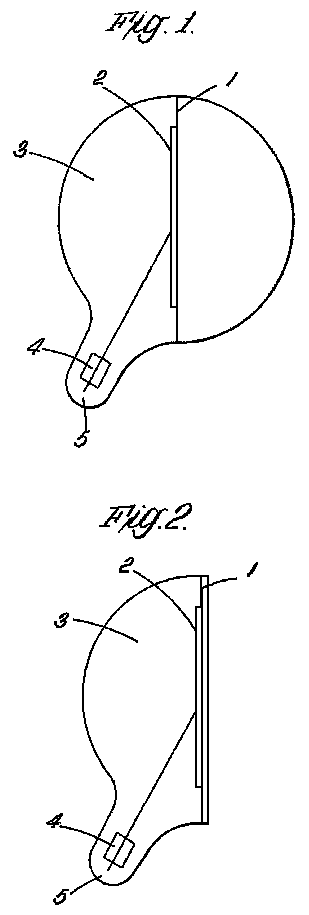
|
|
|
||
|
43. James T. Hawes, AA9DT, “Did J.L. Baird Invent the Trinitron® Tube?,” Hawes Electronic Television Archive. http://www.hawestv.com/etv_baird_not/telechrome_not1.htm Access on 8-18-2019. •Re: Telechrome tube was susceptible to picking up reflections on its curved glass surfaces. The tube walls, unprotected by dag, could absorb ambient light, including light from other chassis tubes. 44. Burns, Television Pioneer, 64-365. •Re: Derivation of 8.3 fps standard that Baird used in several color TV systems. 45. Burns, Television Pioneer, 364-365. •Re: Baird's system of scanning 600-line picture: No available data for Telechrome. But for earlier system with color wheel and CRT, Baird alternated (interlaced) scans of red and scans of cyan. There were 3 scans of each color, with 202.5 lines per scan. Idea was partial compatibility with Marconi-EMI 405-line TV standard. Baird believed that Marconi-EMI sets could receive Baird transmissions as 202.5-line, monochrome pictures (no interlace). Telechrome set could reproduce same signal as 607.5-line, color pictures. Differences between red and cyan field luminance would have caused flicker. Frame rate would drop from 25 fps to 8.3 fps. 46. Burns, Television Pioneer, 381. •Re: Photo of Baird and Telechrome receiver, 1944. Telechrome shows evidence of reflections off its surface. Also, because tube is transparent, external light can interfere with image. Target looks curved, although it is flat. Lensing effect of curved tube envelope would cause this distortion. 47. John Logie Baird, “Improvements in Television Apparatus.” G.B. patent 545,078 filed September 7, 1940 and issued May 11, 1942, p. 2, column 1. •Re: Field-sequential scanning method for color television. Allows British 405-line, black-and-white system to reproduce color frames with 607.5 lines. Frame rate drops to one-third of normal, 8.3 fps. Errors: On line 15, Baird imprecisely rounds the frame rate to “8½ per second”. On p. 1, column 1, he erroneously refers to “a colour frequency of 25 per second.” 48. John Logie Baird, “Improvements in Colour Television Apparatus.” G.B. patent 562,334 filed October 10, 1942 and issued June 28, 1944, p. 1, column 1. •Re: Baird admits that his field-sequential scanning method can cause substantial flicker: “In this system colour flicker is excessive where large areas of one colour are shown.” To minimize such flicker, the patent proposes line-sequential scanning. 49. Burns, Television Pioneer, 376-377. •Re: Field-sequential flicker in color TV pictures. (Telechrome used field-sequential scanning.) Baird submits idea for alleviating this flicker by substituting line-sequential color for field-sequential. No evidence that Baird ever tried line-sequential means. 50. Burns, Television Pioneer, 406-407. •Re: Telechrome scanning at other frame rates besides 8.3 frames per second (fps). In memo to Hankey Committee, Baird made this claim: "5. Definition can be increased to 600 line or the present 405 lines used." In his statements, Baird doesn't name Telechrome. (Baird's words are suggestions and hopes, rather than reports of his accomplishments.) 51. NASA Johnson, “Astronaut Charles Duke During an Apollo 16 Lunar Surface EVA,” YouTube. Online video clip, publication date August 1, 2011, URL: https://www.youtube.com/watch?v=NiJ54Jj2rck (Access on July 29, 2019). •Re: Example of spurious color fringes that are artifact of field-sequential scanning. Watch for fringes whenever Astronaut Charlie Duke swings hammer or makes sudden move. (Video length: 1:16.) 52. Abramson, 1880, 242. •Re: Valensi patented his method for combining the color and brightness signals onto a single-channel channel. 53. Burns, Television Pioneer, 374-377. •Re: After Telechrome, Baird's next attempt at an electronic color TV tube was a line-sequential system. (British patent 562,334, October 10, 1942.) Apparently Baird never built it. 54. Brown, Three Dimensions, 114-115 & 121. •Re: Baird's alleged musings suggest to Mr. Brown that Baird posthumously invented Trinitrons, or perhaps all masked color CRTs. 55. Brown, Three Dimensions, 108 & 111. •Re: Author surmises that Flechsig's patent and tube derive from Baird or Telechrome. Point requires credulous reader, since Flechsig's patent preceded Telechrome patent. 56. Burns, Television Pioneer, 196. •Re: Founding of Fernseh in 1930: Baird, Bosch, Zeiss, and Lowe. 57. Michael Buckland, Emanuel Goldberg and His Knowledge Machine: Information, Invention, and Political Forces (Westport, CT: Libraries Unlimited, 2006), 134-137. •Re: More details about how Fernseh began. Buckland, 135 says that the company started on June 11, 1929 (not 1930). 58. Abramson, 1942, 43. •Re: The German Fernseh GmbH was Werner Flechsig's employer. 59. Margaret Baird, Television Baird (Cape Town: Haum, 1973), 125-126. •Re: J.L. Baird and Fernseh. According to J.L. Baird, relationship with Fernseh terminated in 1933. 60. Brown, Three Dimensions, 108. •Re: False assertion that Baird first invented original multi-cathode CRT (Telechrome). 61. Flechsig, “Cathode ray tube,” 2 & 5. •Re: Flechsig shadow-mask tube drawing, figures 1 and 2 from patent, showing three-gun structure. 62. Abramson, 1880, 80-81. •Re: Baird's Telechrome (1942) wasn't the first multi-neck or multi-cathode tube. Zworykin's first cathode ray tube (1923) had multiple necks. See photo, 80. 63. Ibid.: 145. •Re: War devastation at Baird’s Sydenham home. 64. Margaret Baird, 19, 128, 150. •Re: J.L. Baird was a socialist. 65. Ibid.: 135. •Re: J.L. Baird’s disinterest in marketing.66. Herbert, 26. •Re: Telechrome demonstration took place in 1944. 67. Margaret Baird, 146-147, 155-156. •Re: Baird’s steeply declining health. 68. Burns, 386, 388. •Re: Deterioration of Baird’s health at time of Telechrome demonstration. 69. Sydney Moseley, John Baird: The Romance and Tragedy of the Pioneer of Television (London: Odhams Press, n.d.), 243-247. (Although uncited, publication date was 1952.) •Re: Downturn in Baird's health, starting in the mid-1940s. 70. John Logie Baird & (uncredited) Margaret Baird, Television and Me, ed. Malcolm Baird (Edinburgh, 2004: Mercat Press Limited), 141, 143. •Re: Baird's failing health & last days. (Baird's wife Margaret wrote final chapter of this book. This footnote refers to her chapter 10. Baird's son Malcolm edited entire biography. Malcolm added footnotes, corrections (mostly on names and dates), & artwork. 71. Margaret Baird, 154. •Re: Baird’s desire to enter post-war TV industry. 72. Burns, 385-387. •Re: Baird plans to open new TV company after war. 73. John Logie Baird & (uncredited) Margaret Baird, Television and Me,, 138. •Re: Baird's “dream of being in the forefront when peace came and television would resume...” (Baird's wife Margaret wrote final chapter of this book. This footnote refers to her chapter 10. 74. Ibid.: 387. •Re: Baird’s new company produced huge consoles. 75. Ibid.: 380. •Re: Baird's Telechrome tube was derivative. It contained few, if any, original ideas. 76. Webb, Tele-Visionaries, 90-91. •Re: Importance of shadow mask, by an inventor of RCA color TV equipment. 77. Herold, “A History of Color Television Displays,” 1333. •Re: Shadow-mask tube was "most propitious color picture tube." Flechsig's conception of tube in 1938. 78. Wikipedia, “Internationale Funkausstellung Berlin”, 2018, access on March 10, 2018 (Wikipedia article about Berlin Radio Show, 1939). •Re: Prototype TV with working Flechsig tube on public display. 79. Herbert, Seeing by Wireless, 26. •Re: Herbert describes Baird's Telechrome press conference. |
CONTENTS
- Unknown Innovator
- Winning Features
- First Shadow Mask
- How did the shadow mask work?
- Schroeder vs. Flechsig vs. Lawrence
- Shadow Mask Tubes vs. Telechrome
- Telechrome Tube Dimensions
- More Telechrome Drawbacks
- Alleged Impact of Flechsig on Baird
- Alleged Impact of Baird on Flechsig
- The Value of Telechrome
- Flechsig's Legacy
- References
- Visit these related pages
PHOTOS & DRAWINGS
- Flechsig Tube, 1938
- Different Types of Masks
- Size Comparison, Flechsig Set vs. Telechrome
- Baird & Short-Neck, 2-Color Tube
- Long-Neck, 2-Color Tube (Science Museum)
- Telechrome Optical Problems
- Diagram: Screen Seems to Bend Outward
- Flechsig Tube had 3 Guns
- Patent GB562,433: Figures 1 & 2
